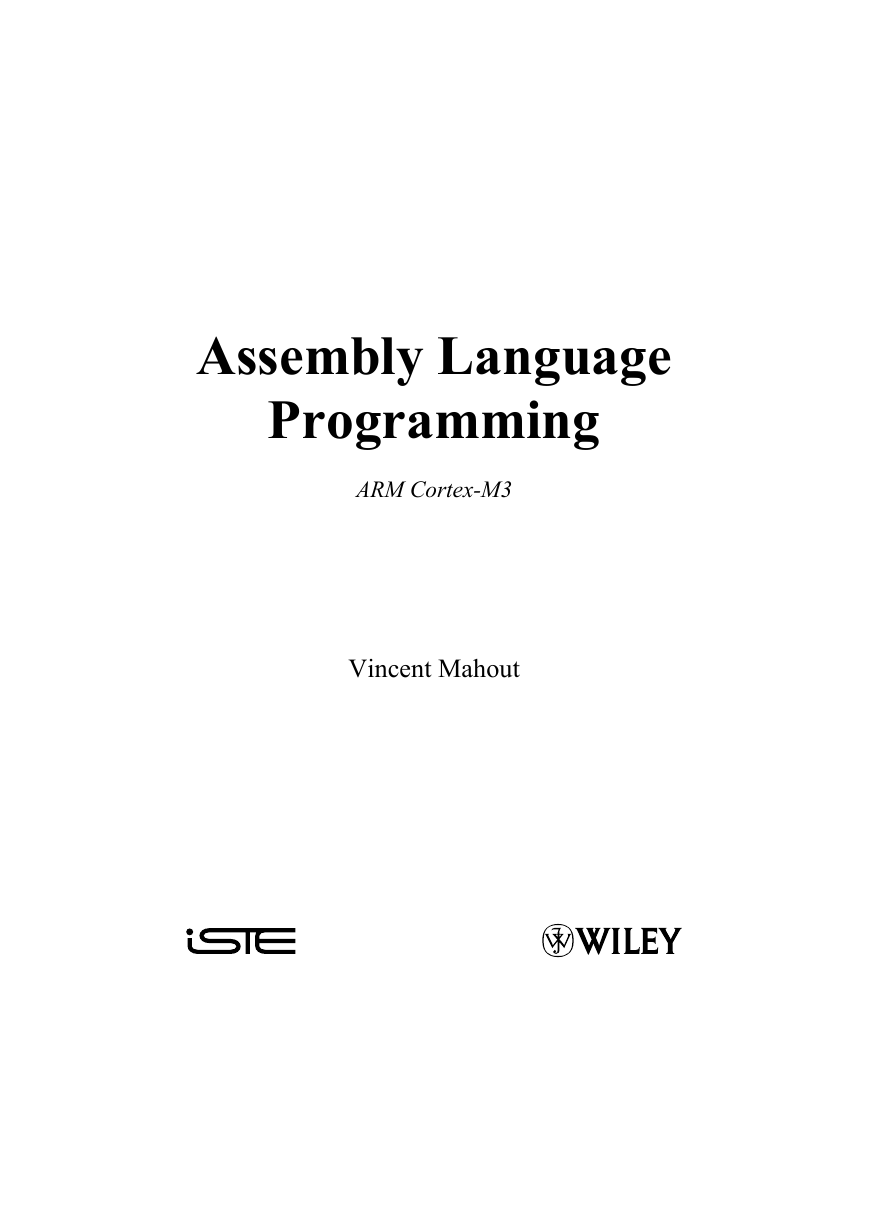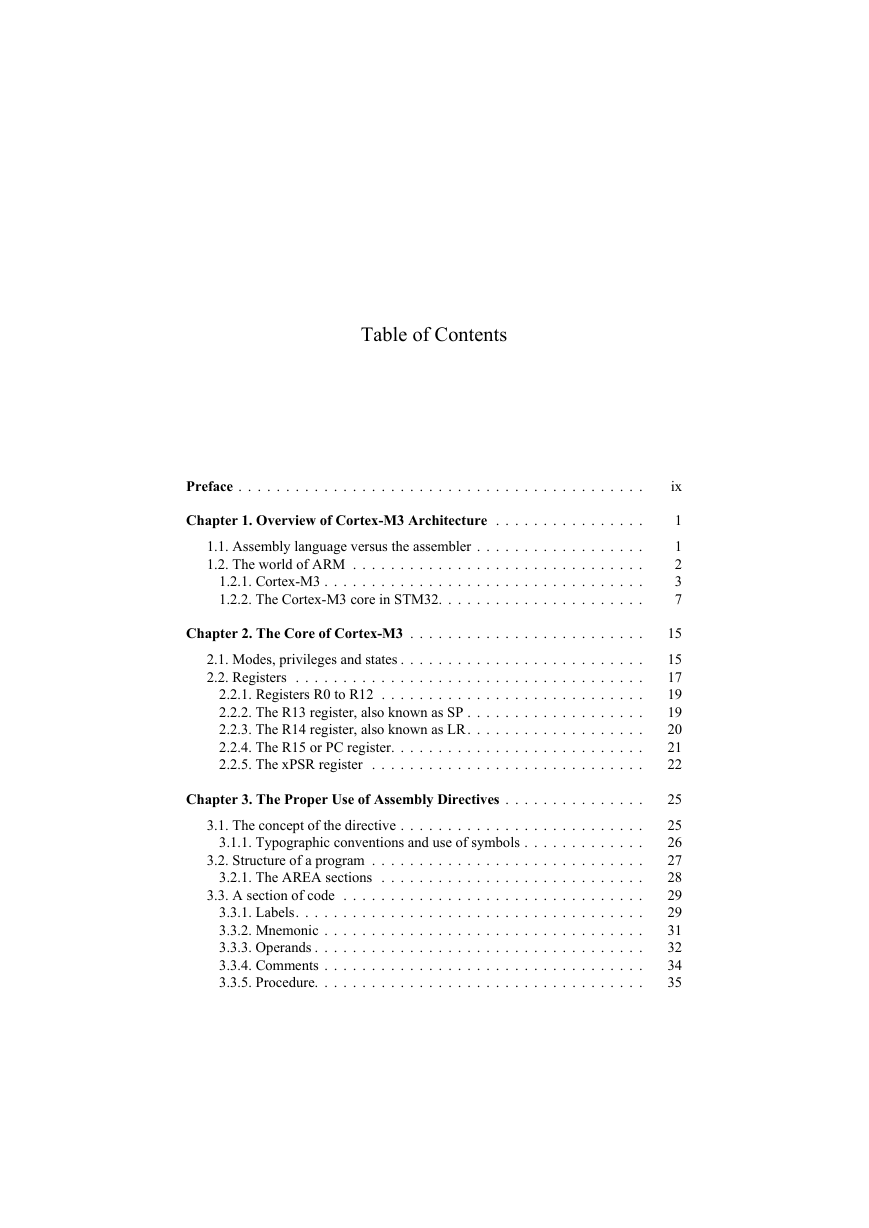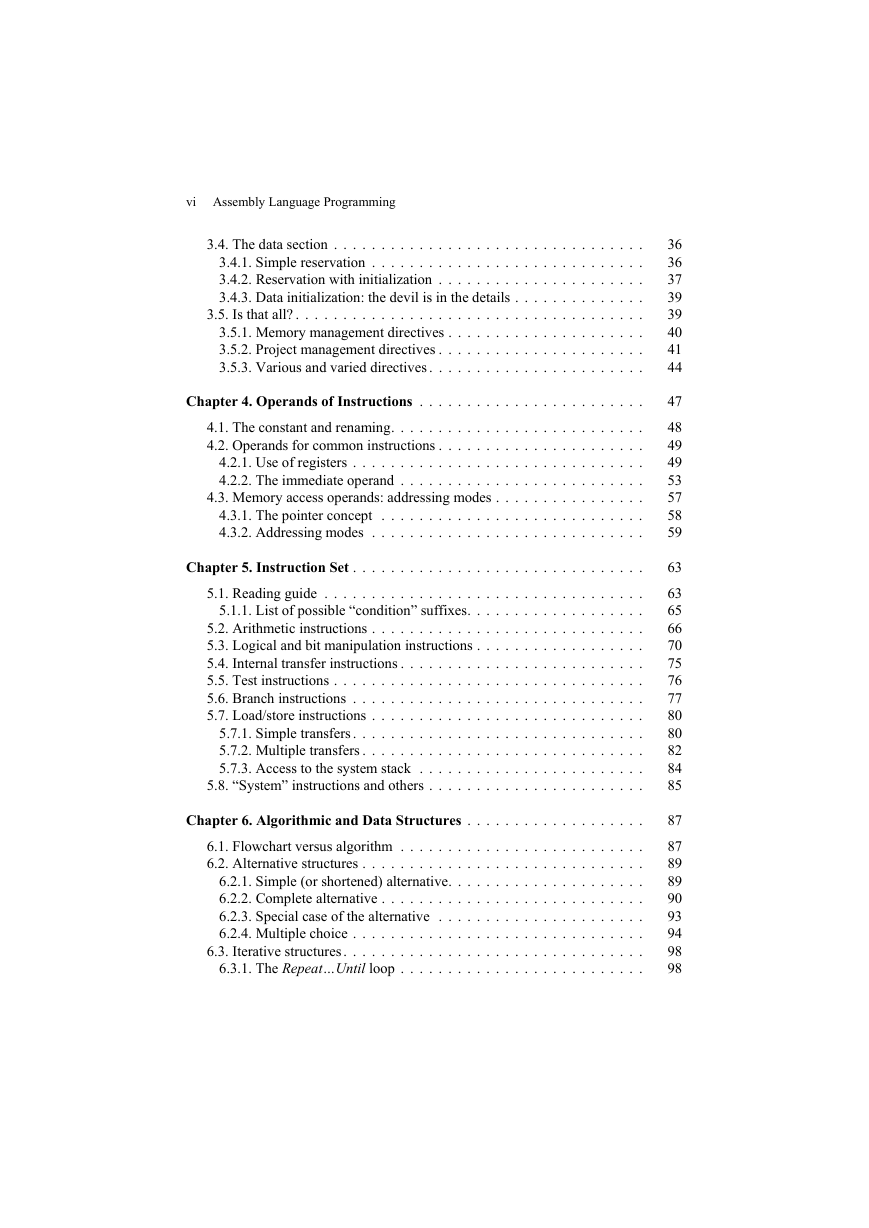Cover
Assembly Language Programming
Title Page
Copyright Page
Table of Contents
Preface
Chapter 1. Overview of Cortex-M3 Architecture
1.1. Assembly language versus the assembler
1.2. The world of ARM
1.2.1. Cortex-M3
1.2.2. The Cortex-M3 core in STM32
Chapter 2. The Core of Cortex-M3
2.1. Modes, privileges and states
2.2. Registers
2.2.1. Registers R0 to R12
2.2.2. The R13 register, also known as SP
2.2.3. The R14 register, also known as LR
2.2.4. The R15 or PC register
2.2.5. The xPSR register
Chapter 3. The Proper Use of Assembly Directives
3.1. The concept of the directive
3.1.1. Typographic conventions and use of symbols
3.2. Structure of a program
3.2.1. The AREA sections
3.3. A section of code
3.3.1. Labels
3.3.2. Mnemonic
3.3.3. Operands
3.3.4. Comments
3.3.5. Procedure
3.4. The data section
3.4.1. Simple reservation
3.4.2. Reservation with initialization
3.4.3. Data initialization: the devil is in the details
3.5. Is that all?
3.5.1. Memory management directives
3.5.2. Project management directives
3.5.3. Various and varied directives
Chapter 4. Operands of Instructions
4.1. The constant and renaming
4.2. Operands for common instructions
4.2.1. Use of registers
4.2.2. The immediate operand
4.3. Memory access operands: addressing modes
4.3.1. The pointer concept
4.3.2. Addressing modes
Chapter 5. Instruction Set
5.1. Reading guide
5.1.1. List of possible “condition” suffixes
5.2. Arithmetic instructions
5.3. Logical and bit manipulation instructions
5.4. Internal transfer instructions
5.5. Test instructions
5.6. Branch instructions
5.7. Load/store instructions
5.7.1. Simple transfers
5.7.2. Multiple transfers
5.7.3. Access to the system stack
5.8. “System” instructions and others
Chapter 6. Algorithmic and Data Structures
6.1. Flowchart versus algorithm
6.2. Alternative structures
6.2.1. Simple (or shortened) alternative
6.2.2. Complete alternative
6.2.3. Special case of the alternative
6.2.4. Multiple choice
6.3. Iterative structures
6.3.1. The Repeat…Until loop
6.3.2. The While…Do loop
6.3.3. The For… loop
6.4. Compound conditions
6.4.1. Alternative with AND
6.4.2. Iteration with AND
6.4.3. Alternative with OR
6.4.4. Iteration with OR
6.5. Data structure
6.5.1. Table in one dimension
6.5.2. Tables in multiple dimensions
6.5.3. Registration
6.5.4. Non-dimensional table, character string
6.5.5. Queue
6.5.6. Stack
Chapter 7. Internal Modularity
7.1. Detailing the concept of procedure
7.1.1. Simple call
7.1.2. Nested calls
7.1.3. “Red wire” example
7.2. Procedure arguments
7.2.1. Usefulness of arguments
7.2.2. Arguments by value and by reference
7.2.3. Passing arguments by general registers
7.2.4. Passing arguments by a stack
7.2.5. Passing arguments by the system stack
7.2.6. On the art of mixing
7.3. Local data
7.3.1. Simple reservation of local data
7.3.2. Using a chained list
Chapter 8. Managing Exceptions
8.1. What happens during Reset?
8.2. Possible exceptions
8.2.1. Traps
8.2.2. Interrupts
8.3. Priority management
8.3.1. Priority levels and sublevels
8.3.2. The nested mechanism
8.4. Entry and return in exception processing
8.4.1. Re-routing
8.4.2. Return
8.4.3. “Tail-chaining” and “Late-arriving”
8.4.4. Other useful registers for the NVIC
Chapter 9. From Listing to Executable: External Modularity
9.1. External modularity
9.1.1. Generic example
9.1.2. Assembly by pieces
9.1.3. Advantages of assembly by pieces
9.1.4. External symbols
9.1.5. IMPORT and EXPORT directives
9.2. The role of the assembler
9.2.1. Files produced by the assembler
9.2.2. Placement counters
9.2.3. First pass: symbol table
9.2.4. Second pass: translation
9.2.5. Relocation table
9.3. The role of the linker
9.3.1. Functioning principle
9.3.2. The products of the linker
9.4. The loader and the debugging unit
Appendices
Appendix A. Instruction Set – Alphabetical List
Appendix B. The SysTick Timer
Appendix C. Example of a “Bootstrap” File
Appendix D. The GNU Assembler
Bibliography
Index
















 2023年江西萍乡中考道德与法治真题及答案.doc
2023年江西萍乡中考道德与法治真题及答案.doc 2012年重庆南川中考生物真题及答案.doc
2012年重庆南川中考生物真题及答案.doc 2013年江西师范大学地理学综合及文艺理论基础考研真题.doc
2013年江西师范大学地理学综合及文艺理论基础考研真题.doc 2020年四川甘孜小升初语文真题及答案I卷.doc
2020年四川甘孜小升初语文真题及答案I卷.doc 2020年注册岩土工程师专业基础考试真题及答案.doc
2020年注册岩土工程师专业基础考试真题及答案.doc 2023-2024学年福建省厦门市九年级上学期数学月考试题及答案.doc
2023-2024学年福建省厦门市九年级上学期数学月考试题及答案.doc 2021-2022学年辽宁省沈阳市大东区九年级上学期语文期末试题及答案.doc
2021-2022学年辽宁省沈阳市大东区九年级上学期语文期末试题及答案.doc 2022-2023学年北京东城区初三第一学期物理期末试卷及答案.doc
2022-2023学年北京东城区初三第一学期物理期末试卷及答案.doc 2018上半年江西教师资格初中地理学科知识与教学能力真题及答案.doc
2018上半年江西教师资格初中地理学科知识与教学能力真题及答案.doc 2012年河北国家公务员申论考试真题及答案-省级.doc
2012年河北国家公务员申论考试真题及答案-省级.doc 2020-2021学年江苏省扬州市江都区邵樊片九年级上学期数学第一次质量检测试题及答案.doc
2020-2021学年江苏省扬州市江都区邵樊片九年级上学期数学第一次质量检测试题及答案.doc 2022下半年黑龙江教师资格证中学综合素质真题及答案.doc
2022下半年黑龙江教师资格证中学综合素质真题及答案.doc